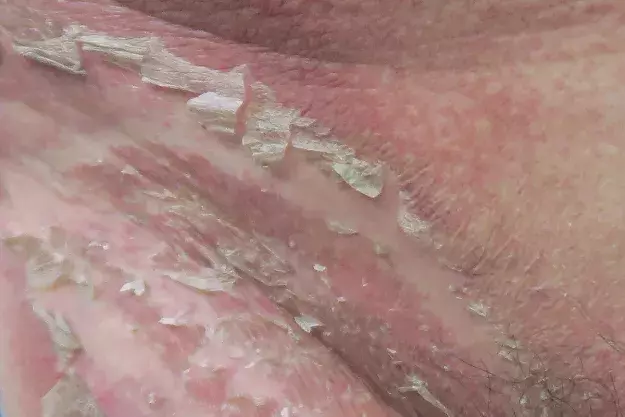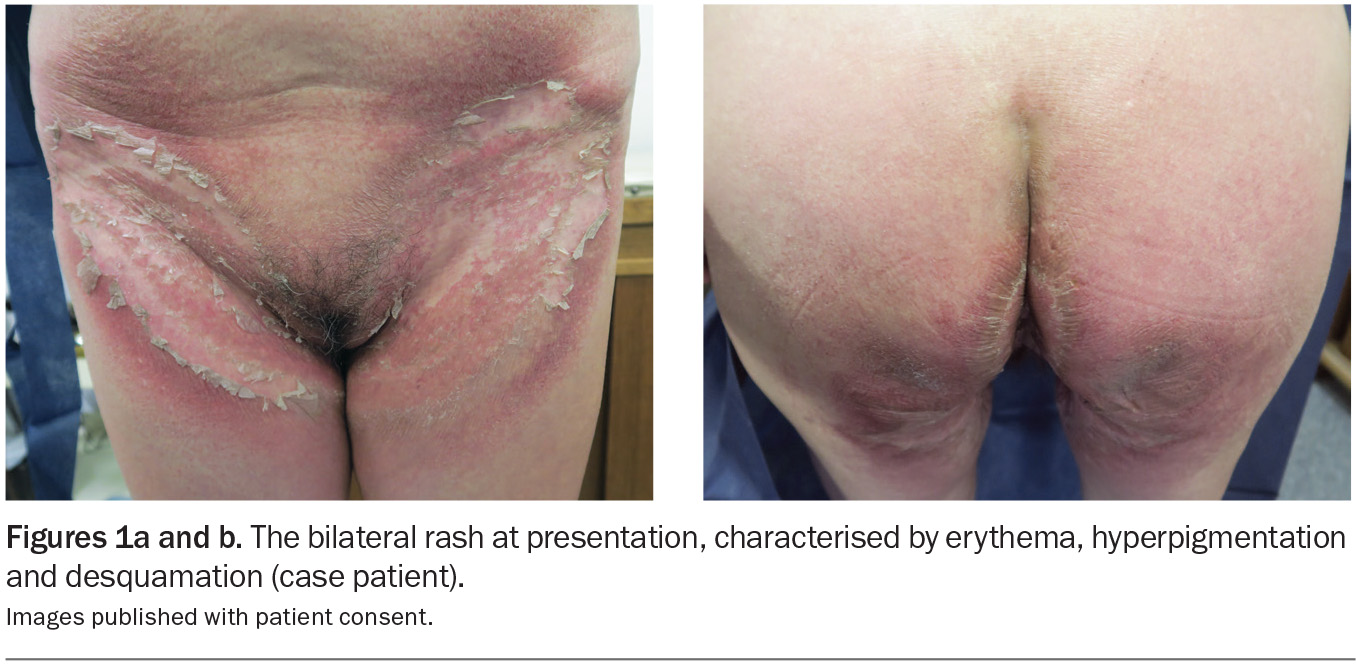What’s the diagnosis?
A woman with a painful groin rash

Case presentation
A 67-year-old woman of Han Chinese ethnicity presents with a three-month history of a burning rash affecting her groin and buttocks. The rash has been treated with a combination 1% clotrimazole and 1% hydrocortisone cream (applied daily for one month) and subsequently with 0.1% mometasone furoate cream and then betamethasone dipropionate ointment. There was minimal or no improvement with any of these treatments.
At the time of presentation, the patient has stopped all medicated topical treatments and she has been applying only sorbolene cream for the preceding two weeks. During this time, she has developed increasing skin pain and barely been able to walk or sit.
The patient was previously well. Her medical history is unremarkable and she is not taking any regular medications.
On examination, a bilateral rash characterised by erythema, hyperpigmentation and desquamation is observed, with the groin creases, upper thighs, buttocks and intergluteal cleft affected (Figures 1a and b).
Differential diagnoses
Conditions to consider among the differential diagnoses include the following.
Intertrigo
Intertrigo presents as a poorly defined area of erythema and maceration in intertriginous regions.1 Friction, moisture and heat are potential irritants. Predisposing factors include comorbidities such as obesity, diabetes and hyperhidrosis. Poor hygiene or living in a hot or humid environment also increases the risk.1
For the case patient, intertrigo was unlikely to be the correct diagnosis because she did not have any risk factors for the condition. In addition, her clinical history was more consistent with a different diagnosis, as discussed later.
Seborrhoeic dermatitis
Seborrhoeic dermatitis presents as a well-demarcated, pink-yellow, dull red or red-brown rash with moist patches or thin plaques and a flaky or greasy scale.1 It is most commonly found in areas with a high density of sebaceous glands, such as the scalp, face, ears and upper chest, but can also be found in intertriginous regions. The incidence is higher in men than women. Although the pathogenesis of seborrhoeic dermatitis is not completely understood, proliferation of Malassezia has been found to be a significant causative factor.1 There is no genetic predisposition.
For the case patient, seborrhoeic dermatitis was unlikely to be the correct diagnosis because the common areas were not affected.
Flexural psoriasis
Flexural (inverse) psoriasis presents as a well-demarcated rash with thin pink or red plaques, which may make it difficult to distinguish from seborrhoeic dermatitis.1 Some scale may be found in the creases (generally less than in chronic plaque
psoriasis) and there is often a fissure in the centre of the crease.1 The rash is also shiny. Flexural psoriasis is most commonly found in the intergluteal cleft, inguinal creases, axillae and inframammary region.1
Psoriasis may occur in intertriginous regions only, but it is important to look for psoriatic plaques elsewhere on the body, such as on the scalp, elbows, hands, genitals, knees and feet.1 Nail changes may also be found.
The case patient’s clinical history and biopsy results (discussed below) made a diagnosis of flexural psoriasis unlikely.
Candidiasis
Candidiasis is a common fungal infection of the axillae and groin. It presents as an intensely erythematous rash with moist desquamation and satellite papules and/or pustules, without a distinct margin.1 The infection starts in the crease and spreads outwards with an irregular edge. Rarely, central clearing may be found. It may be itchy or painful.2
Risk factors for candidiasis include occlusion, hyperhidrosis and diabetes, as well as the use of antibiotics or corticosteroids, and immunosuppression.1 It is more common in women than men.2 If suspected, a skin swab or scraping should be taken for fungal microscopy and culture to confirm the diagnosis and to exclude a secondary bacterial infection.
For the case patient, candidiasis was unlikely to be the correct diagnosis because the rash was very painful and there were no satellite papules. In addition, the results of skin swabs and scrapings were negative.
Tinea cruris
Tinea cruris, a dermatophytosis of the groin area, may extend to the inner thigh and buttock, with the scrotum sometimes being spared in men.1,2 Typically itchy, the lesions are annular with a minimally scaly erythematous border that may contain pustules or vesicles. There can be central clearing.1 Care should be taken to prevent spreading the infection from one anatomical site to another – for example, avoiding cross-contamination by not allowing clothing in contact with both the foot and groin and by using different towels). The most common pathogens are Tinea rubrum, Tinea interdigitale and Epidermophyton floccosum.2
For the case patient, tinea cruris was unlikely to be the correct diagnosis because the rash was painful rather than itchy, and there had been no improvement with topical antifungal therapy.
Erythrasma
Erythrasma presents as a pink, red or brown patch with a fine scale. The infection is caused by an overgrowth of Corynebacterium species.2 Under a Wood’s lamp, erythrasma will demonstrate a coral-red fluorescence, which is diagnostic.1 The condition is more common in adults than children, and diabetes is a predisposing factor. It most commonly affects the axillae, submammary region, periumbilical area, groin, intergluteal cleft and the webspaces of the toes.
For the case patient, erythrasma was unlikely to be the correct diagnosis because the results of skin swabs were negative and clinical examination with Wood’s lamp did not reveal a coral-red fluorescence.
Granular parakeratosis
This is the correct diagnosis. Granular parakeratosis, which is also known as hyperkeratotic flexural erythema, can be caused by a variety of irritants in household and personal hygiene products.3 Benzalkonium chloride – a detergent used as a disinfectant and sanitising agent – is one of the best documented causes, with two case series showing it to be a causative factor when its use in the final rinse water of a laundry cycle caused individuals to become exposed to residual amounts of the irritant on their clothing.4-6 Previously a rare dermatosis, presentations of granular parakeratosis have become more common as a result of the increasing use of these laundry products during the COVID-19 pandemic.7 Other causes of granular parakeratosis include zinc oxide as well as deodorants and antiperspirants.
Granular parakeratosis presents as itchy, sometimes painful, intertriginous erythema with hyperpigmentation and scaling. It is generally diagnosed clinically, but a punch biopsy can be performed to confirm the diagnosis.1 Histological findings include parakeratosis with retention of keratohyaline granules within the base of parakeratotic scale.1 The area should be swabbed to exclude a secondary bacterial or fungal infection.
For the case patient, questioning revealed that she had been using a laundry product containing benzalkonium chloride for the past three years. A punch biopsy was performed to confirm the clinical diagnosis; however, this is not always required if there is a high degree of clinical suspicion. Histological examination of the sample revealed the typical features of granular parakeratosis.
Management
Granular parakeratosis may eventually resolve spontaneously after elimination of the causative agent.8 However, it is typically very difficult to manage during the acute period and might persist for months or longer despite treatment.1 Relapse is common. There are currently no established management guidelines.
Identification of causative agents
The causative agents of granular parakeratosis must be identified and eliminated. The patient’s use of all personal and household products should be reviewed. Repeated washes are required to adequately rid clothing of benzalkonium chloride so it is often preferable to discard garments entirely, particularly undergarments. The washing machine should be rinsed or cleaned thoroughly according to the manufacturer’s instructions.
Skin care advice
Basic skin care advice should always be provided. This includes use of a gentle shampoo and a small amount of a soap-free cleanser for the face and body. A plain moisturiser should be massaged gently into the axillae and/or groin at least twice a day for several weeks. Long hot showers should be avoided.
Topical therapies
Topical corticosteroid therapies, such as 0.1% methylprednisolone aceponate
ointment or 0.05% betamethasone dipropionate ointment, are often used to treat granular parakeratosis. However, there is not much evidence to support their use, with some case reports showing significant benefit and others showing minimal or no improvement.4,9-11
Systemic therapies
There are mixed reports of success for oral antibiotics in managing patients with granular parakeratosis. A small study
has shown improvement in three of four patients who were treated with amoxicillin-clavulanic acid monotherapy.9 Another study demonstrated clearance of the rash with four weeks of treatment with oral doxycycline in combination with topical coconut oil.12 Oral antibiotics should be administered if a secondary bacterial infection develops, which is not uncommon.
In severe cases of granular parakeratosis, oral prednisolone, 0.5 mg/kg/day tapered over three to four weeks, can be considered.
Outcome
The case patient was diagnosed with granular parakeratosis caused by benzalkonium chloride. She was advised to stop using the laundry detergent, to clean her washing machine and to replace her underwear.
The patient commenced treatment with oral prednisolone, 25 mg daily for one week, then 12.5 mg daily with further weaning. She was advised to use a plain intensive moisturiser for very dry skin on the affected areas.
On review four weeks later, her rash had improved significantly. However, she still required a low dose of prednisolone, which continued to be reduced with the aim of ceasing treatment one week later. MT
COMPETING INTERESTS: None.
References
1. Bolognia JL, Schaffer JV, Cerroni L, eds. Dermatology. 4th ed. Philadelphia, PA: Elsevier; 2018.
2. Griffiths C, Barker J, Bleiker T, Chalmers R, Creamer D. In: Rook’s Textbook of Dermatology, 9th ed. West Sussex, UK: Wiley Blackwell; 2010.
3. Ip KH, Li A. Clinical features, histology, and treatment outcomes of granular parakeratosis: a systematic review. Int J Dermatol 2022; 61: 973-978.
4. Dear K, Gan D, Stavrakoglou A, Ronaldson C, Nixon RL. Hyperkeratotic flexural erythema (more commonly known as granular parakeratosis) with use of laundry sanitizers containing benzalkonium chloride. Clin Exp Dermatol 2022; 47: 2196-2200.
5. Robinson AJ, Foster RS, Halbert AR, King E, Orchard D. Granular parakeratosis induced by benzalkonium chloride exposure from laundry rinse aids. Australas J Dermatol 2017; 58: e138-140.
6. Tian CJl, Purvis, Cheng HS. Granular parakeratosis secondary to benzylkonium chloride exposure from common household laundry rinse aids. N Z Med J 2021; 134: 128-142.
7. Nixon R, Patel K. COVID anxiety may have fuelled rise in granular parakeratosis. The Medical Republic, June 2022. pp. 28-30.
8. Lucero R, Horowitz D. Granular parakeratosis. Treasure Island, FL: StatPearls Publishing [internet]; 2023.
9. Kumarasinghe SP, Chandran V, Raby E, Wood B. Hyperkeratotic flexural erythema responding to amoxicillin-clavulanic acid therapy: Report of four cases. Australas J Dermatol 2019; 60: 311-314.
10. Chamberlain AJ, Tam MM. Intertriginous granular parakeratosis responsive to potent topical corticosteroids. Clin Exp Dermatol 2003; 28: 50-52.
11. Channual J, Fife DJ, Wu JJ. Axillary granular parakeratosis. Cutis 2013; 92: 61-66.
12. Herat A, Gonzalez Matheus G, Kumarasinghe
SP. Hyperkeratotic flexural erythema/granular parakeratosis responding to doxycycline. Australas J Dermatol 2022; 63: 368-371.


